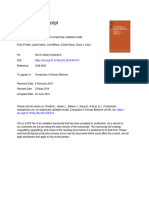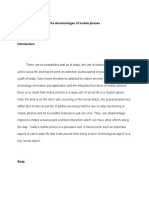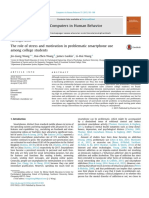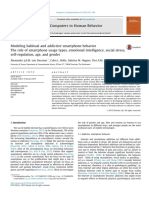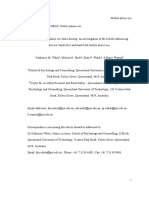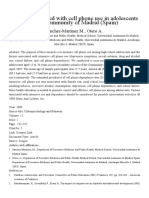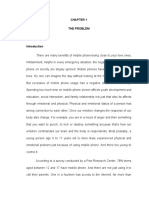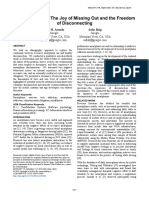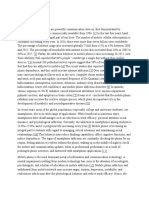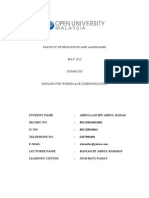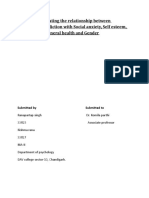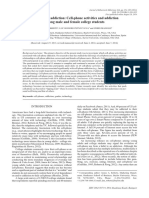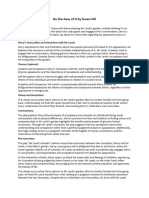Psychological Predictors of Problem Mobile Phone Use: Adriana Bianchi, Pgraddippsych and James G. Phillips, PH.D
Uploaded by
Jatin JoharPsychological Predictors of Problem Mobile Phone Use: Adriana Bianchi, Pgraddippsych and James G. Phillips, PH.D
Uploaded by
Jatin JoharCYBERPSYCHOLOGY & BEHAVIOR Volume 8, Number 1, 2005 Mary Ann Liebert, Inc.
Psychological Predictors of Problem Mobile Phone Use
ADRIANA BIANCHI, PGradDipPsych and JAMES G. PHILLIPS, Ph.D.
ABSTRACT Mobile phone use is banned or illegal under certain circumstances and in some jurisdictions. Nevertheless, some people still use their mobile phones despite recognized safety concerns, legislation, and informal bans. Drawing potential predictors from the addiction literature, this study sought to predict usage and, specifically, problematic mobile phone use from extraversion, self-esteem, neuroticism, gender, and age. To measure problem use, the Mobile Phone Problem Use Scale was devised and validated as a reliable self-report instrument, against the Addiction Potential Scale and overall mobile phone usage levels. Problem use was a function of age, extraversion, and low self-esteem, but not neuroticism. As extraverts are more likely to take risks, and young drivers feature prominently in automobile accidents, this study supports community concerns about mobile phone use, and identifies groups that should be targeted in any intervention campaigns.
INTRODUCTION
ESPITE THE PHENOMENAL uptake of mobile phone technology since its introduction in 19831,2 and the potential advantages conferred,3,4 mobile phone use is not without its disadvantages. There are certain mobile phone behaviors that are considered to be problematic, and as a result, there are an increasing number of legislative and societal controls seeking to govern aspects of their use. Mobile phones are consequently banned in a variety of settings, including hospitals, planes, and petrol stations.
The ban on hand-held telephones while driving has been based on the belief that physical manipulation of the mobile phone, for example, having to hold it up to the ear, would lead to a decrement in driving performance.6,811 Correlational studies comparing crash data and the use of mobile phones lend weight to the potential dangers of mobile phone use while driving.1215 Although these driving studies are limited by various factors,16,17 a statistical association, though not causal, has been established, and researchers in this area all urge further research. Other problem use of mobile phones. There are also concerns that some mobile phone users incur considerable debt,18 and that mobile phones are being used to violate privacy19,20 and to harass others.21 In particular, there is increasing evidence that mobile phones are being used as a tool by children to bully other children.22,23 These observations highlight the fact that problem mobile phone behaviors exist. However, whilst there are societal and legislative controls in place for some of these behaviors, it has become
Problem use of mobile phones Mobile phones and driving. Using a hand-held mobile phone while driving is against the law in many countries (e.g., Australia, New Zealand, in some states in the United States2), although laws are patchy and may vary at a state level. Driving simulation studies indicate that dual tasking, such as using a mobile phone while driving, can be detrimental to driving performance.57
Psychology Department, Monash University, Australia.
39
40
BIANCHI AND PHILLIPS
evident that people disregard these bans in favor of using their mobile phones in the face of potential dangers.12 It is in light of the fact that people continue to use their mobile phones despite bans on use and knowledge of potential hazards, that researchers and psychologists need to be concerned about the behavioral and psychological mechanisms that play a role in defining problem mobile phone behavior. As mobile phone technology is a relatively new technology, one has to ask where do these problem behaviors come from? Problems may arise from lack of societal controls24 and/or from a lack of selfcontrol on the behalf of the user. However, it is not clear why people do not exert the necessary selfcontrol when use might be inappropriate. Problem behavior associated with mobile phones is probably due to pre-existing factors that make it likely that the user will engage in such behavior despite the consequences. In the absence of any previous research in this area, the literature relating to addiction and, in particular, psychological predictors of addiction will be used as a basis from which to develop scales to document and explain problem mobile phone behavior.
Gender and technology Historically, there appears to have been gender differences in relation to the uptake of new technology. Past research, for example, has found that men are more likely than women to hold positive attitudes towards computers31 and are thus more likely to embrace computer technology. A logical extension of this suggests that males will be more likely than females to fall prey to problematic use of computers and the Internet, as they are more likely to use computers in the first instance. Some research has shown that this is indeed the case.29,32,33 However, the research findings on technology and gender are not conclusive.34,35 Perhaps initial gender differences are a function of socialization and access to technology, and that with time, it is quite possible that any reported gender differences will cease to exist. Certainly, it appears that attitudes toward computer technology are changing, and women now appear to have a more favorable attitude.31 Given the inconsistencies, it is difficult to say how this will translate into the uptake of mobile phone technology by males and females. The anecdotal evidence is that both men and women have embraced mobile phone technology equally. Age and technology Past research has shown that older people are less likely than younger people to embrace new technology.36,37 Brickfield36 has found that part of the reason for this may be that older people have less positive attitudes towards a variety of technologies than do younger people, which means they are also less likely to use new technological products. Based on such evidence, we would not expect older mobile phone users to spend as much time on their mobile phones as younger users, or to experience as many mobile phonerelated problems. Self-esteem and addiction Self-esteem is the relatively stable evaluation a person makes and maintains of him- or herself, and tends to be a judgment of worth of the self.38 Selfesteem is bound up with our self views of our identity, and our self views are sustained by our social relationships.39 Swann39 believes that, through our interactions with others, we absorb cultural beliefs that tell us how members of our group should seek self-worth. There are indications that, for the younger demographic in particular, mobile phones
Behavioral addiction The traditional concept of addiction was based on a medical model and referred to dependence associated with the ingestion of a substance, either drugs or alcohol. Lately, researchers have begun to question this medical model of addiction as the definitive model and have argued that the concept of addiction needs to cover a broader range of behaviors. Many researchers have thus argued for the validity of a behavioral addiction model.2527 In this vein, the concept of technological addiction has been examined. Griffiths28 believes that technological addictions are a subset of behavioral addictions, and operationally defines technological addictions as a behavioral addiction that involves humanmachine interaction and is non-chemical in nature. Regardless of whether excessive use of various forms of technology can or should be labeled an addiction, researchers have found some evidence for excessive use of technology that can be deemed problematic.29,30 Irrespective of whether these behavioral problems are actually addictions or not, this still serves as a useful starting point for an examination of problem behaviors such as problem mobile phone use.
MOBILE PHONE USE
41
are becoming an important part of their culture.22,40,41 Mobile phone ownership may, in this way, play an important role in subgroup culture and, in turn, self-esteem. Self-esteem has consistently been linked to addictive behavior.42 Baumeister43 theorizes that low self-esteem may cause people to behave in ways that are self-defeating in order to escape self-awareness. Mobile phones may be addictive in that they may be used as a form of escape from situations that the user finds aversive. Based on the literature related to self-esteem and addiction, we would expect to find in this study that higher and problematic use of mobile phones can be predicted by low self-esteem. Extraversion and problem use of mobile phones Eysenck and Eysenck44 define the typical extravert as sociable, needing to have people to talk to, and disliking reading or studying by him- or herself. The extravert likes to take chances, is generally impulsive, and craves excitement. For several reasons, extraversion will be an important predictor of problem mobile phone use. Firstly, like self-esteem, extraversion has been implicated in addictive behavior. Eysenck and Eysenck45 suggest that the underlying cause of extraversion is a tendency towards underarousal, which would make the extravert more likely to seek out stimulation. Sensation seekers require novel and varied sensations and experiences, and are willing to take social and physical risks for the sake of such experiences.46 This trait has been linked to addictive behavior4648 and to risk taking and problem behavior.49,50 Sensation seeking has also been linked to aberrant driving behavior.51 Although the connection to addiction is not definitive,52,53 it has generally been established that extraverts are more susceptible to addictive behaviors such as alcoholism54 and drug addiction.55 Secondly, suboptimal arousal may mean that extraverts are more susceptible to problem use of mobile phones on the grounds that they are more likely to seek out social situations. Sociability is one of the major defining features of extraversion,44 and as a consequence, extraverts would tend to have a larger circle of friends and social networks. This might promote higher levels of mobile phone use, with the potential to be inappropriate in certain circumstances, such as in planes, in hospitals, or while driving. Lastly, extraversion could also be a predictor of higher and problem use of mobile phones on the
grounds that they appear to be a tool of social influence.22,41 Previous studies have shown that extraverts are more susceptible to peer influence.5658 For the above reasons, we would expect extraversion to be an important predictor of higher and problem mobile phone use. Neuroticism and problem mobile phone use High neuroticism is characterized by anxiousness, worrying, moodiness, and frequent depression. The neurotic individual is overly emotional, reacts strongly to many stimuli, and finds it difficult to relax after an emotionally arousing experience.44 Like self-esteem and extraversion, neuroticism has been linked to several excessive behaviors such as anorexia and bulimia,52 and drug addiction.55 For this reason, we would expect that higher and problem mobile phone use will be predicted by neuroticism. Development of the Mobile Phone Problem Usage Scale Excessive and/or problematic mobile phone use has not been studied to date. This research attempts to establish an instrument to measure the phenomenon, based on the literature relating to addiction and incorporating questions relating to the social aspect of mobile phone use. Construct validity of the Mobile Phone Problem Usage Scale (MPPUS) will be demonstrated by its relationship to other indicators of problem use. The MPPUS should correlate with other measures of mobile phone use, including the self-reported amount of time spent using a mobile phone during the week; the number of people the user calls on a regular basis; and the average monthly mobile phone expenditure. Another suitable indicator of the MPPUS construct validity is to determine its relationship with an already established measure of addiction. For this purpose, the MMPI-2 Addiction Potential Scale,59 which is currently used to measure the potential for substance abuse and alcoholism, will be correlated with the MPPUS. Further, this research will attempt to determine the construct validity of the MPPUS by determining whether the personality traits of low selfesteem, extraversion, and neuroticism will be related to problem use of mobile phones. Whilst there are difficulties in determining a personality type, or even personality traits that are consistently associated with addiction,42 low self-esteem, extraversion, and neuroticism have all been linked to addictive behavior in the literature. The present
42
BIANCHI AND PHILLIPS
research will thus seek to predict mobile phone use and problem mobile phone use from age, gender, self-esteem, extraversion, and neuroticism.
MATERIALS AND METHODS
Participants A total of 324 questionnaires were distributed, of which 199 were returned (a response rate of 61%). There were 195 useable questionnaires, and consequently 195 participants in this study (132 females and 62 males; one missing), with a mean age of 36.07 years (standard deviation = 12.43 years). Ages ranged from 18 to 85 years. Participants were limited to those 18 years of age and over, and who own a mobile phone or use a mobile phone regularly. Participants were recruited from several university campuses and the general public via personal appeal, and an advertisement calling for volunteers was placed in the local suburban newspaper, which ran for a period of 5 weeks from 27 August 2003 to 24 September 2003. Materials The MMPI-2 Addiction Potential Scale, the Coopersmith Self Esteem Inventory, the Eysenck Personality QuestionnaireRevised Short Scale, and a Mobile Phone Use Survey were employed in this study. MMPI-2 Addiction Potential Scale. The MMPI-2 Addiction Potential Scale (APS)59 was used to address the validity of the MPPUS. The APS is a 39item empirically derived scale used for assessing personality characteristics and lifestyle patterns that are associated with drug and alcohol abuse. Reliability data for the MMPI-2 is generally positive, with median internal-consistency coefficients (alpha) typically in the 0.70s and 0.80s, but as low as 0.30s for some scales in some samples.60 Validity of the MMPI-2 is healthy, with a validity coefficient averaging 0.46 for MMPI studies conducted between 1970 and 1981.60 For the APS, test-retest reliabilities have been reported59 as being 0.77 for females and 0.69 for males. The alpha coefficient for the APS in the present study was 0.51. The lower reliability is in keeping with Gregorys findings60 and could be due to restriction of range. The APS was developed using normative, psychiatric, and substance abuse samples.59 As the sample for this study is considered to be normal, the reliability for the APS was not as good as is desired.
Coopersmith Self Esteem Inventory. The Coopersmith Self Esteem Inventory (SEI) is a 25-item questionnaire, designed to measure evaluative attitudes toward the self in social, academic, family, and personal areas of experience.38 The SEI was employed in this research to examine the personality trait of self-esteem, particularly low self-esteem, which has been linked to addictive behavior. The SEI has a good level of reliability (alpha coefficient 0.79 for males and 0.83 for females) and good construct validity.38 Analysis of the reliability of the SEI for this study revealed an alpha coefficient of 0.81. Eysenck Personality QuestionnaireRevised Short Scale. The Eysenck Personality QuestionnaireRevised Short Scale (EPQ) is a 48-item questionnaire assessing Eysencks three major dimensions of personalitythat of extraversion-introversion, neuroticism, and psychoticism. There is also a scale to measure the validity of a persons responses (Lie Scale). The EPQ has good reliability: alpha coefficients of 0.88 for males and 0.84 for females on the Extraversion Scale, and 0.84 for males and 0.80 for females on the Neuroticism Scale.44 Construct validity is also well established.60 The reliability of the Extraversion Scale in this study was 0.87 and of the Neuroticism Scale was 0.82. Mobile Phone Use Survey. The Mobile Phone Use Survey consisted of three sections addressing (a) demographic details, (b) mobile phone usage, and (c) problem usage. The demographic section with four questions addressed participants age, gender, level of education, and income range. The section on mobile phone usage consisted of six questions addressing how long participants have owned a mobile phone, how much time each week is spent using the mobile phone, and the percentage of usage that is related to (a) social calls, (b) business calls, and (c) other features. Those participants who indicated they used other features were asked to indicate which other features they used. The other questions in this section addressed percentage of time spent sending and receiving text messages (Short Message Service [SMS]); how many people the participant calls on a regular basis; and the average monthly mobile phone expenditure. The third section addressing problem usage (MPPUS) listed a series of questions based on the addiction literature and, in particular, what is currently known about behavioral and technological addiction. Twenty-seven questions covered the issues of tolerance, escape from other problems, withdrawal, craving, and negative life conse-
MOBILE PHONE USE
43
quences in the areas of social, familial, work, and financial difficulties. These questions included issues such as a persons loss of control over their amount of mobile phone usage and time spent on mobile phonerelated activities. The scale also included some questions related to the social motivational aspects of mobile phone use that are based
on the extraversion literature. These include questions such as All my friends own a mobile phone and My friends dont like it when my mobile phone is switched off. All questions in this section were on a Likert-type scale ranging from 1 (not true at all) to 10 (extremely true). The questions may be seen in Table 1.
TABLE 1. MOBILE PHONE PROBLEM USE SCALE 1. I can never spend enough time on my mobile phone. 2. I have used my mobile phone to make myself feel better when I was feeling down. 3. I find myself occupied on my mobile phone when I should be doing other things, and it causes problems. 4. All my friends own a mobile phone. 5. I have tried to hide from others how much time I spend on my mobile phone. 6. I lose sleep due to the time I spend on my mobile phone. 7. I have received mobile phone bills I could not afford to pay. 8. When out of range for some time, I become preoccupied with the thought of missing a call. 9. Sometimes, when I am on the mobile phone and I am doing other things, I get carried away with the conversation and I dont pay attention to what I am doing. 10. The time I spend on the mobile phone has increased over the last 12 months. 11. I have used my mobile phone to talk to others when I was feeling isolated. 12. I have attempted to spend less time on my mobile phone but am unable to. 13. I find it difficult to switch off my mobile phone. 14. I feel anxious if I have not checked for messages or switched on my mobile phone for some time. 15. I have frequent dreams about the mobile phone. 16. My friends and family complain about my use of the mobile phone. 17. If I dont have a mobile phone, my friends would find it hard to get in touch with me. 18. My productivity has decreased as a direct result of the time I spend on the mobile phone. 19. I have aches and pains that are associated with my mobile phone use. 20. I find myself engaged on the mobile phone for longer periods of time than intended. 21. There are times when I would rather use the mobile phone than deal with other more pressing issues. 22. I am often late for appointments because Im engaged on the mobile phone when I shouldnt be. 23. I become irritable if I have to switch off my mobile phone for meetings, dinner engagements, or at the movies. 24. I have been told that I spend too much time on my mobile phone. 25. More than once I have been in trouble because my mobile phone has gone off during a meeting, lecture, or in a theatre. 26. My friends dont like it when my mobile phone is switched off. 27. I feel lost without my mobile phone.
44
BIANCHI AND PHILLIPS
Reliability and validity of the MPPUS A test of internal reliability (Cronbachs alpha) was calculated on the MPPUS to demonstrate the level of internal consistency among items. A Cronbachs alpha of 0.93 was obtained, demonstrating a high level of internal consistency and suggesting that items are homogenous and related to the construct of mobile phone problem use. To assess the validity of the MPPUS, relationships with other measures of mobile phone use were examined using the Pearson correlation coefficient. One measure of mobile phone use is selfreported time spent using the mobile phone during the week. There was a moderately strong positive correlation between the scores on the MPPUS and the reported time spent using the mobile phone, r = 0.45, p < 0.01. Other measures of mobile phone use include the number of people called on a regular basis and the average monthly expenditure. Both showed moderate to strong correlations with the MPPUS with r = +0.42, p < 0.01 and r = +0.43, p < 0.01, respectively. The MPPUS was also moderately correlated with an established scale for measuring addictionthe APS, r = +0.34, p < 0.01. These moderate to strong correlations with other measures of mobile phone use and an established scale for measuring addiction support the construct validity of the MPPUS and provide evidence for the construct of problem mobile phone use. Procedure Participants were recruited by personal appeal, poster recruitment, and advertisement. Participants were required to complete the survey and three personality scales by giving the most appropriate response to each item, and were then required to return the questionnaires in the replypaid envelope provided.
Data analyses The total score for the MPPUS was calculated by summing the scores of each item per participant. Scores for the APS, SEI, and EPQ were totaled as per the instructions in the manuals. Descriptive statistics for all variables in the Mobile Phone Use Survey (excluding the MPPUS) were calculated. Separate multiple regressions were carried out for each dependent variable to determine whether they could be predicted from the independent variables. The predictor variables were (a) age, (b) gender, (c) low self-esteem as measured by the SEI, (d) extraversion, and (e) neuroticism as measured by the EPQ. The dependent variables were (a) reported time per week spent using the mobile phone, (b) mobile phone problem use as measured by the MPPUS, (c) reported percentage of use that is socially based, (d) reported percentage of use that is business based, (e) reported percentage of use in other features, (f) reported percentage of use that is SMS based, and (g) reported number of people called on a regular basis. The data from the questionnaire was entered into SPSS (version 11.5). The chosen level of significance was an alpha level of 0.05.
RESULTS
Analysis of the independent variables The totals, means, and standard deviations of age, gender, self-esteem, extraversion, and neuroticism were calculated along with the minimum, maximum, and skew for each of the independent variables. The results are presented in Table 2. Descriptive statistics of all three personality measures are comparable to the normative data presented in the manuals.38,44 An inspection of the skew of the independent variables revealed that age was positively skewed,
TABLE 2. MEANS AND STANDARD DEVIATIONS, MINIMUM, MAXIMUM, AND SKEW OF AGE, GENDER, SELF-ESTEEM, EXTRAVERSION, AND NEUROTICISM IV Age Gender Self-esteem Extraversion Neuroticism n 193 194 195 195 195 Mean 36.08 1.68 73.76 7.72 5.67 SD 12.44 0.47 18.55 3.62 3.33 Min. 18 1 16 0 0 Max. 85 2 100 12 12 Skew 0.95 0.78 0.88 0.44 0.07
MOBILE PHONE USE
45
TABLE 3. MEANS AND STANDARD DEVIATIONS, MINIMUM, MAXIMUM, AND SKEW OF TIME SPENT USING THE MOBILE PHONE PER WEEK, MPPUS SCORE, SOCIAL USE, BUSINESS USE, USE OF OTHER FEATURES, AND SMS USE DV Time using during the week in minutes Number of people called on a regular basis MPPUS score Social use as percentage of total use Business use as percentage of total use Use of other features as percentage of total use SMS use as percentage of total use Mean 123.32 5.47 64.86 70.75 26.19 2.99 31.19 SD 213.32 5.57 31.60 32.24 31.91 7.24 30.85 Min 2.00 0.00 27.00 0.00 0.00 0.00 0.00 Max 1800.00 40.00 210.00 100.00 100.00 60.00 98.00 Skew 4.42 2.70 1.49 0.83 0.96 4.49 0.629
and extraversion and self-esteem were negatively skewed. As self-esteem and extraversion were negatively skewed, these scales were inverted by subtracting them from a maximum value before transformations were applied. A logarithm (+1) transformation was used on the variable of age. Square root transformations were used on the extraversion and self-esteem variables. Due to the transformation, the extraversion variable was inverted, and this variable has now been named introversion to assist in interpretability. Likewise, the self-esteem variable was inverted and is now named low self-esteem. The assumption of normality was achieved after the data were transformed. To screen for univariate outliers, a cutoff of z > 3.29, p < 0.001 was applied. To screen for multivariate outliers using Mahalanobis distances, cases with values greater than 20.515 (Chi Square, df = 5, p < 0.001) were to be excluded.61 No univariate or multivariate outliers were detected after the transformations were applied, and therefore no cases needed to be deleted. Pearsons correlations were performed on all independent variables before and after transformation, to test for multi-collinearity. There were a few significant correlations, but all were below the selection criteria of 0.99,61 and therefore there were no violations of this assumption. Prediction of heavier and problematic mobile phone use Overall mobile phone use was operationalized in terms of self-reported time spent using the mobile phone per week and the number of people called on a regular basis. The type of mobile phone use was also analyzed and broken down into the categories of self-reported percentage of social use, business use, use of other features, and total use that is SMS-based. Problematic mobile phone use was operationalized by obtaining a score from the
MPPUS. The means, standard deviations, minimum, maximum, and skew were calculated for these dependent variables, the results of which are presented in Table 3. All dependent variables with the exception of social use were positively skewed, with the time variable and use of other features being highly positively skewed. The time variable and MPPUS score were transformed by logarithm, and after transformation, the assumption of normality was achieved. For the sake of interpretation, the other variables were not transformed. Separate multiple regressions were employed to predict heavier use and problem use. Overall use. The multiple regression analysis to predict whether gender, age, low self-esteem, extraversion, and neuroticism would predict selfreported time spent using the mobile phone during the week was highly significant [F(5,189) = 11.285, p < 0.001], accounting for 21.5% of the variance in this variable. In particular, young people [ = 0.38; t(189) = 5.45, p < 0.001], and extraverted people [ = 0.23; t(189) = 3.20, p < 0.002], use the mobile phone more. Results of this regression are presented in Table 4.
TABLE 4. STANDARDIZED REGRESSION COEFFICIENT (), t-VALUE OF , AND SIGNIFICANCE VALUES FOR PREDICTORS OF TIME SPENT USING THE MOBILE PHONE DURING THE WEEK Predictors Gender Age Low self-esteem Introversion Neuroticism 0.12 0.38 0.11 0.23 0.01 t 1.82 5.45 1.18 3.20 0.14 p 0.07 0.001 0.24 0.002 0.89
46
BIANCHI AND PHILLIPS
TABLE 5. STANDARDIZED REGRESSION COEFFICIENT (), t-VALUE OF , AND SIGNIFICANCE VALUES FOR PREDICTORS OF THE NUMBER OF PEOPLE CALLED REGULARLY USING THE MOBILE PHONE Predictors Gender Age Low self-esteem Introversion Neuroticism 0.22 0.13 0.01 0.21 0.04 t 3.14 1.80 0.09 2.84 0.42 p 0.002 0.073 0.932 0.005 0.679
TABLE 7. STANDARDIZED REGRESSION COEFFICIENT (), t-VALUE OF , AND SIGNIFICANCE VALUES FOR PREDICTORS OF SOCIAL USE OF THE MOBILE PHONE Predictors Gender Age Low self-esteem Introversion Neuroticism 0.31 0.16 0.07 0.03 0.98 t 4.45 2.15 0.72 0.38 1.07 p 0.001 0.033 0.474 0.71 0.288
Another indicator of use is how many people participants call on a regular basis. The independent variables could significantly predict 8.7% of this variable [F(5,193) = 4.678, p < 0.001. It appears that males [ = 0.22; t(193) = 3.14, p < 0.002] and extraverts [ = 0.21; t(193) = 2.84, p < 0.005] call more people on a regular basis. The results of this analysis are presented in Table 5. Problem use. The independent variables could also significantly predict 40% of the scores on the MPPUS [F(5,193) = 26.595, p < 0.001]. It appears that high scores on the MPPUS are a function of age, low self-esteem, and extraversion. Young people [ = 0.46; t(193) = 7.74, p < 0.001], extraverts [ = 0.24; t(193) = 3.92, p < 0.001], and people with low self-esteem [ = 0.24; t(193) 3.04, p < 0.003] tended to score higher on the MPPUS than others. Table 6 reports the results of this analysis. Type of use. The independent variables could also significantly predict the types of use of mobile phones in the categories of social, business, and SMS use. The independent variables predicted 10.6% of social use [F(5,193) = 5.561, p < 0.001].
Young people [ = 0.16; t(193) = 2.15, p < 0.05] and females [ = 0.31; t(193) = 4.45, p < 0.001] are more likely to use the mobile phone for social reasons. The results of this multiple regression are presented in Table 7. The independent variables could also predict 10.6% of business use [F(5,193) = 5.542, p < 0.001]. Males [ = 0.27; t(193) = 3.82, p < 0.001], and older people [ = 0.21; t(193) 2.96, p < 0.004] tend to use the mobile phone more for business purposes. The results of this multiple regression are presented in Table 8. In addition, the independent variables could predict 33.4% of total mobile phone use that is SMSbased [F(5,193) = 20.266, p < 0.00]. It is younger people [ = 0.52; t(193) = 8.39, p < 0.001] who use the SMS function on mobile phones more. The results of this multiple regression are presented in Table 9. Lastly, the independent variables could also predict 5.3% of the variance in mobile phone use that is related to other features [F(5,192) = 3.148, p < 0.009]. Younger people [ = 0.28; t(192) = 3.71, p < 0.001] tend to use the other features on their mobile phones more. The results of this regression are presented in Table 10.
TABLE 6. STANDARDIZED REGRESSION COEFFICIENT (), t-VALUE OF , AND SIGNIFICANCE VALUES FOR PREDICTORS OF HIGH SCORES ON THE MPPUS Predictors Gender Age Low self-esteem Introversion Neuroticism 0.09 0.46 0.24 0.24 0.13 t 1.64 7.74 3.04 3.92 1.67 p 0.103 0.001 0.003 0.001 0.096
TABLE 8. STANDARDIZED REGRESSION COEFFICIENT (), t-VALUE OF , AND SIGNIFICANCE VALUES FOR PREDICTORS OF BUSINESS USE OF THE MOBILE PHONE Predictors Gender Age Low self-esteem Introversion Neuroticism 0.27 0.21 0.08 0.04 0.10 t 3.82 2.96 0.85 0.47 1.09 p 0.001 0.004 0.398 0.638 0.279
MOBILE PHONE USE
47
TABLE 9. STANDARDIZED REGRESSION COEFFICIENT (), t-VALUE OF , AND SIGNIFICANCE VALUES FOR PREDICTORS OF USE OF THE MOBILE PHONE THAT IS SMS BASED Predictors Gender Age Low self-esteem Introversion Neuroticism 0.05 0.52 0.05 0.10 0.10 t 0.88 8.39 0.65 1.48 1.19 p 0.380 0.001 0.52 0.140 0.236
TABLE 10. STANDARDIZED REGRESSION COEFFICIENT (), t-VALUE OF , AND SIGNIFICANCE VALUES FOR PREDICTORS OF USE OF THE MOBILE PHONE THAT IS OTHER FEATURES Predictors Gender Age Low self-esteem Introversion Neuroticism 0.07 0.28 0.06 0.02 0.05 t 0.99 3.71 0.60 0.23 0.48 p 0.321 0.001 0.56 0.82 0.63
DISCUSSION
Mobile phones are a relatively recent technology, being in popular use for just over two decades. Law makers regard some forms of use as problematic. This being so, people are prone to exhibit other problem behaviors (for example, behavioral or technological addictions) might be expected to exhibit problems with mobile phones.
Extraversion As predicted, extraversion could explain both overall use, as measured by time spent using the mobile phone during the week, and problem use, as measured by higher scores on the MPPUS. Whilst extraversion has been linked to addictive behavior,54,55 it is also not surprising that it was related to overall use and problem use, as extraverts are fundamentally social in nature. And, as the mobile phone is a tool which is primarily used for communication, it makes sense that the two are inextricably linked. Whilst extraversion does not predict proportion of social use of the mobile phone, it does predict the number of people called on a regular basis. The latter is not surprising as one would expect extraverts to have a larger number of people in their social networks with whom they communicate regularly. Nevertheless, as social use was not predicted by extraversion, it implies that extraverts use the phone more often overall for some other purpose, such as stimulation, and that a social purpose is not necessarily the primary driver for phone use. This is in keeping with the hypothesis that extraverts seek social contact because they are primarily underaroused.45 If extraverts are more susceptible to risk-taking, problem behavior,49 and sensation seeking,45,46 then the link found in this research to higher overall use and problem use may have direct implications for policy makers considering the dangers of inappropriate mobile phone use. The present data suggest that the people using these phones more often also tend to take risks and are more likely to use the phones inappropriately. Low self-esteem Although lower self-esteem did not predict overall use, it did predict problem use of mobile
Problem use of mobile phones: a psychological construct In order to assess problematic mobile phone use, it was necessary to formulate a reliable and valid measuring instrument. The MPPUS exhibited a good level of internal consistency as indicated by Cronbachs alpha coefficient. The MPPUS also has good construct validity as it correlated strongly with other measures of mobile phone use, namely self-reported time spent using the mobile phone during the week, the number of people called on a regular basis, and the average monthly expenditure. The MPPUS was also related to an established measure of addictionthe MMPI-2 Addiction Potential Scale. Taken together, this is evidence for the construct validity of the MPPUS. If problem use of mobile phones has similarities to the addictions, then we would expect that factors linked to other addictions may explain mobile phone use. For this reason, this research expected to find a relationship between low self-esteem, extraversion, and neuroticism, as these are all personality traits that have been linked to addiction or dependencies. In addition, the research expected to find a link between extraversion and higher/problem use of mobile phones on the grounds that mobile phones appear to be used as a tool of social influence, particularly among the young.
48
BIANCHI AND PHILLIPS
phones. Low self-esteem or depression have been linked to other behavioral problems such as problem internet use or problem gambling.62,63 The depression literature notes that those with poor self-esteem or negative self views have a greater tendency to seek reassurance,64 and it is not surprising that these are people who are more likely to use their phones inappropriately. Nevertheless, determining causality is a problem in such studies. It is not clear whether (a) heavier use leads to poor self-esteem by generating problems associated with inappropriate use and high phone bills, or (b) whether poor self-esteem leads to higher usage and greater likelihood of inappropriate use of mobile phones. It is only possible to address causality by longitudinal studies. It is interesting to note that heavier users of mobile phone technology are different than heavier users of the Internet. Heavier users of the Internet can be lonely and use the Internet to displace time and pursue solitary pursuits,65 and it is the quality of such interactions that can contribute to selfesteem.66 In contrast, mobile phones are potentially disruptive and are used more for social purposes. Given Moodys observation that the nature of the interaction is important, it would be interesting to consider whether problem users are predisposed to send or to receive more messages. Neuroticism Unexpectedly, neuroticism was not a factor explaining self-reported time spent using the mobile phone nor problem use as measured by higher scores on the MPPUS. Neuroticism could also not explain the number of people called or types of use. Neurotic people are defined as anxious, moody, and depressed people who tend to be overly emotional and who react strongly to many stimuli.44 It is possible that the mobile phone is a device that is not appealing to people who display neurotic tendencies. Features such as ring tones or even the fact that a mobile phone makes one potentially contactable all the time may not appeal to neurotic people. This may be one reason to explain why neuroticism does not predict overall use or problem use. Although neuroticism has been linked to some types of addiction, such as eating disorders52 and drug addiction,55 as a personality trait it does not appear to feature as a factor in problematic mobile phone use. Perhaps this is because the links between neuroticism and the addictions are not strong. For instance, Zuckerman and Kuhlman67 hypothesize that, while neuroticism is a trait that is
traditionally found in substance abusers, neuroticism may be a direct consequence of the substance abuse, rather than a predictor of it. Thus, as the link between neuroticism and the addictions can be tenuous, it is perhaps not unusual that, in this study, neuroticism did not predict problem use. Age It is not altogether surprising that time spent on the mobile phone during the week and a higher score on the MPPUS are a function of age. That young people, as opposed to older people, should experience more problem use is in keeping with the literature relating to technological addiction in general. In the main, it appears that younger people experience more problem use of technology.35 This is partly due to cultural factors in that younger people are more inclined than older people to embrace new technologies.36 The cultural phenomenon of mobile phone use is also evidenced in this research by the finding that younger people are more likely than older people to use the SMS function and other features on their phones. Quite apart from the evidence that younger people embrace new technologies more than older people, physical limitations may also play a role in this finding. Age-related changes in vision and manual dexterity37 may mean that older people are not physically capable of using the SMS function on their mobile phones, or if they are, their physical limitations may make use of the SMS function and other features uncomfortable or awkward. In addition, education is an issue. The elderly may be less familiar with computer interfaces. Age, however, did predict some aspects of mobile phone use. Older people used the phone more for business purposes. One explanation for this finding is that this sample contained a number of older people who were employed. Many of the younger participants were university students, who would not necessarily use the mobile phone for business purposes at all. This observation may account for such findings. Gender Gender appeared to predict type of use. In particular, females are more likely to use the mobile phone for social reasons. However, somewhat paradoxically, males call more people on a regular basis. This may be partly explained by the finding that males were also found to use the mobile phone more for business purposes. It may be that, in this
MOBILE PHONE USE
49
sample, males had a larger number of people to call in a business context. It is interesting to note that gender did not predict overall time spent using the mobile phone nor of problem use as measured by higher scores on the MPPUS. Given that gender has been found to be a function of some types of technological addiction, that is, males more than females experience problematic use of technology,32,33 then we may have expected to see the same trend in mobile phones. One explanation for the finding that gender is not a predictor may be that the appeal of mobile phones is gender neutral. That is, both males and females have embraced mobile phone technology equally. This may also account for the fact that gender was also not a factor in predicting use of the SMS function of mobile phones. Intervention and management This research did not intend to pathologize behavior that could indeed be classified as a bad habit, but there is a need to recognize the potential negative consequences of inappropriate mobile phone use. Research regularly points to increased risks when driving and using mobile phones. There are also growing trends towards negative financial and social consequences of inappropriate mobile phone use, particularly for younger users. The aim of this research was to provide a first step towards identifying psychological factors that could lead to problematic use of mobile phones. The research attempts to find out why some people will continue to use mobile phones despite signs saying that use is banned (e.g., in hospitals and planes), the existence of legislation against their use and the risk of fines and driving penalties, and ultimately, a knowledge of the potential dangers to self and others. In addition, this research offers a potential window into the evolution of behavioral problems. Heavier mobile phone users are young extroverts, and problem users are more likely to be young and extraverted, and have poor self-esteem. Management of problem use could take several forms. Interventions could focus upon the mobile phone itself. For instance, disclaimers could be presented on the mobile phones menu warning users not to manipulate the phone while driving.68 Indeed, the Global Positioning Systems in some cars in the United States already have the warning that these devices should be programed at the roadside and should only be glanced at while driving. In addition, as the present study implies that mobile phones have a self-stimulatory function, intervention could involve shifting problem users to less stimulating mobile
phones or ones with less intrusive features,69,70 although such a recommendation potentially conflicts with the marketing of these devices.69,70 Australia currently has an advertising campaign that addresses problems fumbling with mobile phones while driving. The present study suggests that a campaign that focuses upon self-stimulatory use that distracts from other obligations in young extraverts with low self-esteem (viz party animals) might target 40% of problem use. However, treating inappropriate mobile phone use may be addressing a symptom, rather than the underlying problem.71 Problem mobile phone use may be a symptom of an impulse control deficit or depression. In such instances, there would be a need to address the underlying problem, as well as inappropriate mobile phone use.
CONCLUSION
This study indicates that the technological addictions offer an appropriate starting point for a consideration of problem mobile phone use. Although neuroticism could not predict higher use or problem use, extraversion and low self-esteem appear to be important factors. Young people, in particular, appear to be susceptible to high use and problem use. They are also greater users of the SMS function and other features on mobile phones. In light of the growing body of literature related to the physical, financial, and social implications of problem mobile phone use, this research may serve as a firststep, indicating for clinicians and policy makers the factors that may be important when dealing with problem use.
ACKNOWLEDGMENT
We would like to acknowledge the helpful advice of Michael Beresford of Telstra Research Laboratories.
REFERENCES
1. Australian Mobile Telecommunications Association. (2003). AMTA 2003 annual report. Canberra, Australian Capital Territory: Author. 2. Goodman, M.J., Tijerina, L., Bents, F.D., et al. (1999). Using cellular telephones in vehicles: safe or unsafe? Transportation Human Factors 1:342. 3. Chapman, S., & Schofield, W.N. (1998). Lifesavers and samaritans: emergency use of cellular (mobile)
50 phones in Australia. Accident Analysis and Prevention 30:815819. Wiederhold, B.K., Wiederhold, M.D., Jang, D.P., et al. (2000). Use of cellular telephone therapy for fear of driving. CyberPsychology & Behavior 3:10311039. Alm, H., & Nilsson, L. (1995). The effects of a mobile telephone task on driver behaviour in a car following situation. Accident Analysis and Prevention 27:707715. Consiglio, W., Driscoll, P., Witte, M., et al. (2003). Effect of cellular telephone conversations and other potential interference on reaction time in a braking response. Accident Analysis and Prevention 35:495 500. Hancock, P.A., Lesch, M., & Simmons, L. (2003). The distraction effects of phone use during a crucial driving maneuver. Accident Analysis and Prevention 35: 501514. Lamble, D., Kauranen, T., Laakso, M., et al. (1999). Cognitive load and detection thresholds in car following situations: safety implications for mobile (cellular) telephones while driving. Accident Analysis and Prevention 31:617623. McKnight, A.J., & McKnight, A.S. (1993). The effect of cellular phone use upon driver attention. Accident Analysis and Prevention 25:259265. Strayer, D.L., & Johnston, W.A. (2001). Driven to distraction: dual task studies of simulated driving and conversing on a cellular telephone. Psychological Science 12:462466. Briem, V., & Hedman, L.R. (1995). Behavioural effects of mobile telephone use during simulated driving. Ergonomics 38:25362563. Laberge-Nadeau, C., Maag, U., Bellavance, F., et al. (2003). Wireless telephones and the risk of road crashes. Accident Analysis and Prevention 35:649 660. Reidelmeier, D.A., & Tibshirani, R.J. (1997). Association between cellular telephone calls and motor vehicle collisions. New England Journal of Medicine 336: 453458. Violanti, J.M. (1998). Cellular phones and fatal traffic collisions. Accident Analysis and Prevention 30:519 524. Violanti, J.M., & Marshall, J.R. (1996). Cellular phones and traffic accidents: an epidemiological approach. Accident Analysis and Prevention 28:265270. Haigney, D., & Westerman, S.J. (2001). Mobile (cellular) phone use and driving: a critical review of research methodology. Ergonomics 44:132143. Ayres, T., Humphrey, D., & Murray, J. (1999). Cellullar telephones and driver caution. Presented at the Silicon Valley Ergonomics Conference and Exposition, ErgoCon 99, Silicon Valley. Griffiths, M., & Renwick, B. (2003). Misfortune or mismanagement: a study of consumer debt issues. Australia: University of Newcastle. Barker, G. (2003). Courts may crack down on mobiles. The Age 17 June:7. Rose, M. (2003). Spy phones banned: pools outlaw mobiles amid privacy fears. Herald Sun 11 June:7.
BIANCHI AND PHILLIPS 21. Telecommunications Industry Ombudsman. (2003). TIO annual report 2003. Melbourne, Victoria: Author. 22. Charlton, T., Panting, C., & Hannan, A. (2002). Mobile telephone ownership and usage among 10- and 11-year olds. Participation and exclusion. Emotional and Behavioral Difficulties 7:152163. 23. NOPWorld. (2001). 21st century kids: bullied by mobile phone [On-line]. Available: www.nop.co.uk/ news/news_survey_21st.shtml. 24. Australasian Legal Information Institute. (n.d.). Road safety (road rules) regulations, 1999 [On-line]. Available: www.austlii.eduau/au/legis/vic/consol_reg/rsrr1999338/. 25. Shaffer, H.J. (1996). Understanding the means and objects of addiction: technology, the internet and gambling. Journal of Gambling Studies 12:461469. 26. Orford, J. (2001). Excessive appetites: a psychological view of the addictions, 2nd ed. Chichester, UK: Wiley. 27. Lemon, J. (2002). Can we call behaviours addictive? Clinical Psychologist 6:4449. 28. Griffiths, M.D. (1996). Gambling on the internet: a brief note. Journal of Gambling Studies 12:471473. 29. Griffiths, M.D. (1998). Internet addiction: does it really exist? In: Gackenbach, J. (ed.), Psychology and the Internet: intrapersonal, interpersonal and transpersonal applications. New York: Academic Press, pp. 6175. 30. Shotton, M.A. (1989). Computer addiction?: a study of computer dependency. London: Taylor & Francis. 31. Ray, C.M., Sormunen, C., & Harris, T.M. (1999). Mens and womens attitudes toward computer technology: a comparison. Information, Technology, Learning and Performance Journal 17:18. 32. Griffiths, M.D., & Hunt, N. (1998). Dependence on computer games by adolescents. Psychological Reports 82:475480. 33. Morahan-Martin, J., & Schumacher, P. (2000). Incidence and correlates of pathological internet use among college students. Computers in Human Behavior 16:1329. 34. Young, K.S. (1996). Psychology of computer use: XL. Addictive use of the internet: a case study that breaks the stereotype. Psychological Reports 79:899 902. 35. Brenner, V. (1997). Psychology of computer use: XL VII. Parameters of internet use, abuse and addiction: the first 90 days of internet usage survey. Psychological Reports 80:879882. 36. Brickfield, C.F. (1984). Attitudes and perceptions of older people. In: Robinson, P.K., & Birren, J.E. (eds.), Aging and technological advances. New York: Plenum, pp. 3138. 37. Charness, N., & Bosman, E.A. (1992). Human factors and age. In: Craik, F.I.M., & Salthouse, T.A. (eds.), The handbook of aging and cognition. Hillsdale, NJ: Lawrence Erlbaum, pp. 495551. 38. Coopersmith, S. (1989). Self-esteem inventories. Palo Alto, CA: Consulting Psychologists Press. 39. Swann, W.B. (1996). Self-traps: the elusive quest for higher self-esteem. San Francisco: W.H. Freeman.
4.
5.
6.
7.
8.
9.
10.
11.
12.
13.
14.
15.
16.
17.
18.
19. 20.
MOBILE PHONE USE 40. Charlton, A., & Bates, C. (2000). Declines in teenage smoking with rise in mobile phone ownership: hypothesis. British Medical Journal 321:1155. 41. Plant, S. (2001). On the mobile: the effects of mobile telephones on social and individual life. Unpublished manuscript. Available on-line: [http://www.motorola.com/ mot/doc/0/234_MotDoc.pdf] 42. Marlatt, A.G., Baer, J.S., Donovan, D.M., et al. (1988). Addictive behaviours: etiology and treatment. Annual Review of Psychology 39:223252. 43. Baumeister, R.F. (1997). Identity, self-concept and self-esteem: the self lost and found. In: Hogan, R., Johnson, J., & Briggs (eds.), Handbook of personality and psychology. San Francisco: Academic Press, pp. 681710. 44. Eysenck, H.J., & Eysenck, S.B.G. (1991). Manual of the Eysenck Personality Scales (EPS Adult). London: Hodder & Stoughton. 45. Eysenck, H.J., & Eysenck, M.W. (1985). Personality and individual differences: a natural science approach. New York: Plenum. 46. Zuckerman, M. (1979). Sensation seeking: beyond the optimal level of arousal. Hillsdale, NJ: Lawrence Erlbaum Associates. 47. Castellani, B., & Rugle, L. (1995). A comparison of pathological gamblers to alcoholics and cocaine misusers on impulsivity, sensation seeking and craving. International Journal of the Addictions 30:275289. 48. Lin, S.S.J., & Tsai, C.G. (2002). Sensation seeking and Internet dependence of Taiwanese high school adolescents. Computers in Human Behavior 18:411426. 49. Trimpop, R.M. (1994). The psychology of risk taking behaviour. Amsterdam: North Holland 50. Wilson, G.D. (1977). Introversion/extraversion. In: Blass, T. (ed.), Personality variables in social behaviour. Hillsdale, NJ: Erlbaum, pp. 179218. 51. Smer, N. (2003). Personality and behavioural predictors of traffic accidents: testing a contextual mediated model. Accident Analysis and Prevention 35:949 964. 52. Davis, C., & Claridge, G. (1998). The eating disorders as addiction: a psychobiological perspective. Addictive Behaviours 23:463475. 53. Mathers, S., & Walker, M.B. (1999). Extraversion and exercise addiction. Journal of Psychology 133:125128. 54. Hill, S., Shen, S., Lowers, L., et al. (2000). Factors predicting the onset of adolescent drinking in families at high risk for developing alcoholism. Biological Psychiatry 48:265275. 55. Gossop, M.R., & Eysenck, S.B.G. (1980). A further investigation into the personality of drug addicts in treatment. British Journal of Addiction 75:305311. 56. Bynner, J.M. (1969). The young smoker. London: HMSO. 57. Rim, Y., & Seidenross, H. (1971). Personality and response to pressure from peers versus adults. Personality 2:3543.
51 58. Sinha, A.K.P., & Ojha, H. (1963). An experimental study of the operation of prestige suggestion in extraverts and introverts. Journal of Social Psychology 61:2934. 59. Weed, N.C., Butcher, J.N., McKenna, T., et al. (1992). New measures for assessing alcohol and drug abuse with the MMPI-2: the APS and the AAS. Journal of Personality Assessment 58:389404. 60. Gregory, R.J. (1996). Psychological testing. History, principles, and applications. Boston: Allyn and Bacon. 61. Tabachnik, B.G., & Fidell, L.S. (2000). Using multivariate statistics, 4th ed. Boston: Allyn and Bacon. 62. Armstrong, L., Phillips, J.G., & Saling, L. (2000). Potential determinants of heavier internet usage. International Journal of Human-Computer Studies 53: 537550. 63. Rodda, S., Brown, S.L., & Phillips, J.G. (2004). The relationship between anxiety, smoking, and gambling in electronic gaming machine players. Journal of Gambling Studies 20:7181. 64. Davison, G.C., & Neale, J.M. (1998). Abnormal psychology. New York: John Wiley & Sons. 65. Scealy, M., Phillips, J.G., & Stevenson, R. (2002). Shyness and anxiety as predictors of patterns of internet usage. CyberPsychology & Behavior 6:507515. 66. Moody, E.J. (2001). Internet use and its relationship to loneliness. CyberPsychology & Behavior 4:393401. 67. Zuckerman, M., & Kuhlman, D.M. (2000). Personality and risk-taking: common biosocial factors. Journal of Personality 68:9991029. 68. Young, K.S., & Case, C.J. (2004). Internet abuse in the workplace: new trends in risk management. CyberPsychology & Behavior 7:105111. 69. Wood, T.A., Griffiths, M.D., Chappell, D., et al. (2004). The structural characteristics of video games: a psycho-structural analysis. CyberPsychology & Behavior 7:110. 70. Choi, D., & Kim, J. (2004). Why people continue to play online games: in search of critical design factors to increase customer loyalty to online contents. CyberPsychology & Behavior 7:1124. 71. Shaffer, H.J., Hall, M.N., & Vander Bilt, J. (2000). Computer addiction: a critical consideration. American Journal of Orthopsychiatry 70:162168.
Address reprint requests to: Dr. James G. Phillips Psychology Department Monash University P.O. Box 17 VIC 3800, Australia E-mail: jim.phillips@med.monash.edu.au
You might also like
- Psychological Predictors of Problem Mobile Phone Use - CyberPsychology & BehaviorNo ratings yetPsychological Predictors of Problem Mobile Phone Use - CyberPsychology & Behavior3 pages
- Addictive Personality and Problematic Mobile Phone Use: Riginal AperNo ratings yetAddictive Personality and Problematic Mobile Phone Use: Riginal Aper9 pages
- Kuss2018 Article ProblematicMobilePhoneUseAndAdNo ratings yetKuss2018 Article ProblematicMobilePhoneUseAndAd9 pages
- Listyo Yuwanto - Development of Mobile Phone - 2012No ratings yetListyo Yuwanto - Development of Mobile Phone - 201215 pages
- Modeling Habitual and Addictive Smartphone BehaviorNo ratings yetModeling Habitual and Addictive Smartphone Behavior10 pages
- Cross-Generational Analysis of Predictive Factors of Addictive Behavior in Smartphone UsageNo ratings yetCross-Generational Analysis of Predictive Factors of Addictive Behavior in Smartphone Usage12 pages
- Schroeter, Ronald Oxtoby, Jim Johnson, Daniel Steinberger, FabiusNo ratings yetSchroeter, Ronald Oxtoby, Jim Johnson, Daniel Steinberger, Fabius10 pages
- Smart Phone Addiction and Family Interaction of Grade 12 Set-F Humss StudentsNo ratings yetSmart Phone Addiction and Family Interaction of Grade 12 Set-F Humss Students13 pages
- Zhang - How Does Self-Esteem Affect Mobile Phone Addiction The Mediating Role ofNo ratings yetZhang - How Does Self-Esteem Affect Mobile Phone Addiction The Mediating Role of6 pages
- International Journal of Home Science 2016 2 (1) : 69-74No ratings yetInternational Journal of Home Science 2016 2 (1) : 69-7412 pages
- Republic of The Philippines Holy Cross College of Carigara Carigara, LeyteNo ratings yetRepublic of The Philippines Holy Cross College of Carigara Carigara, Leyte4 pages
- Factors Associated With Cell Phone Use in Adolescents in The Community of Madrid (Spain)No ratings yetFactors Associated With Cell Phone Use in Adolescents in The Community of Madrid (Spain)4 pages
- Mobile Phone Affecting The Physical and Emotional StatusNo ratings yetMobile Phone Affecting The Physical and Emotional Status27 pages
- Students' Cell Phone Addiction and Their Opinions PDF100% (1)Students' Cell Phone Addiction and Their Opinions PDF7 pages
- Toward "JOMO": The Joy of Missing Out and The Freedom of DisconnectingNo ratings yetToward "JOMO": The Joy of Missing Out and The Freedom of Disconnecting8 pages
- Running Head: Emotional Intelligence and Technology 1No ratings yetRunning Head: Emotional Intelligence and Technology 116 pages
- Smartphone Addiction and Social CapitalNo ratings yetSmartphone Addiction and Social Capital19 pages
- International Journal of Trend in Scientific Research and Development (IJTSRD)No ratings yetInternational Journal of Trend in Scientific Research and Development (IJTSRD)6 pages
- TITLE:-Investigating The Relationship Between Smartphone Addiction With Social Anxiety, Self Esteem, Sleep Quality, General Health and GenderNo ratings yetTITLE:-Investigating The Relationship Between Smartphone Addiction With Social Anxiety, Self Esteem, Sleep Quality, General Health and Gender33 pages
- Nirmal Pvt. Ltd. Sales Analysis 2010-2011No ratings yetNirmal Pvt. Ltd. Sales Analysis 2010-20114 pages
- Croma Retail & Provogue Financial AnalysisNo ratings yetCroma Retail & Provogue Financial Analysis18 pages
- AAA, Ba3, Ca, CCC... They Look Like Some Kind of Hyper-Active SchoolNo ratings yetAAA, Ba3, Ca, CCC... They Look Like Some Kind of Hyper-Active School12 pages
- The Effect of Gender, Ethnicity, and Income On College Students' Use of Communication TechnologiesNo ratings yetThe Effect of Gender, Ethnicity, and Income On College Students' Use of Communication Technologies11 pages
- What Are The Key Features Which Customers Look For. What Are The Competitors StrategyNo ratings yetWhat Are The Key Features Which Customers Look For. What Are The Competitors Strategy1 page
- Outpatient Rooms: Listen To The Dialogue Between Nurses and Patients / Visitors in The Outpatient RoomsNo ratings yetOutpatient Rooms: Listen To The Dialogue Between Nurses and Patients / Visitors in The Outpatient Rooms8 pages
- The Role of Cryotherapy After Total Knee Arthroplasty - A  Systematic ReviewNo ratings yetThe Role of Cryotherapy After Total Knee Arthroplasty - A  Systematic Review7 pages
- Death in Traditional African Societies FormNo ratings yetDeath in Traditional African Societies Form9 pages
- BNAP Programs, Projects, Activities - 2022No ratings yetBNAP Programs, Projects, Activities - 202221 pages
- Engineering Alloys (307) Lecture 7 Titanium Alloys I: David DyeNo ratings yetEngineering Alloys (307) Lecture 7 Titanium Alloys I: David Dye15 pages
- Communication and The Therapeutic RelationshipNo ratings yetCommunication and The Therapeutic Relationship21 pages




